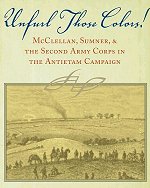 Unfurl Those Colors: McClellan, Sumner, and the Second Army Corps in the Antietam Campaign Sumner's rationale for the movement configuration of Sedgwick's division was logical and in consort with his understanding of McClellan's orders. When the attack disintegrates, Sumner is instrumental in quickly recognizing the disaster and leading the shattered division away from further damage |
Antietam Battle
|
|
|
|

|
Union Losses: 12,410
Confederate Losses: 10,700 Kindle Available  The Long Road To Antietam: How the Civil War Became a Revolution In the summer of 1862, after a year of protracted fighting, Abraham Lincoln decided on a radical change of strategy—one that abandoned hope for a compromise peace and committed the nation to all-out war. |
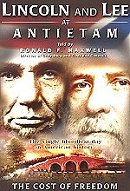 Lincoln and Lee at Antietam: The Cost of Freedom Lincoln and Lee at Antietam covers the entire struggle of the Antietam Campaign. The political concept about why Lincoln needed a Union victory and Lee's need to take the war north were covered as well as the battle. DVD |
|
JOE RYAN'S CIVIL WAR BATTLEWALKS: ANTIETAM AND LEE'S LOST ORDERExplore More Detailed Document Review and Analysis of General Lee's Special Order Youtube Channel JoeRyanCivilWar |
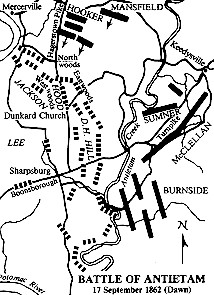 |
 |
 Maryland Voices of the Civil War This book draws upon hundreds of letters, diaries, and period newspapers to portray the passions of a wide variety of people -- merchants, slaves, soldiers, politicians, freedmen, women, clergy, slave owners, civic leaders, and children caught in the emotional vise of war. |
 Union Troops Battling Their Way across Burnside Bridge in the Battle of Antietam 24 in. x 18 in. Buy at AllPosters.com Framed Mounted |
State Park Battlefield Map |
|
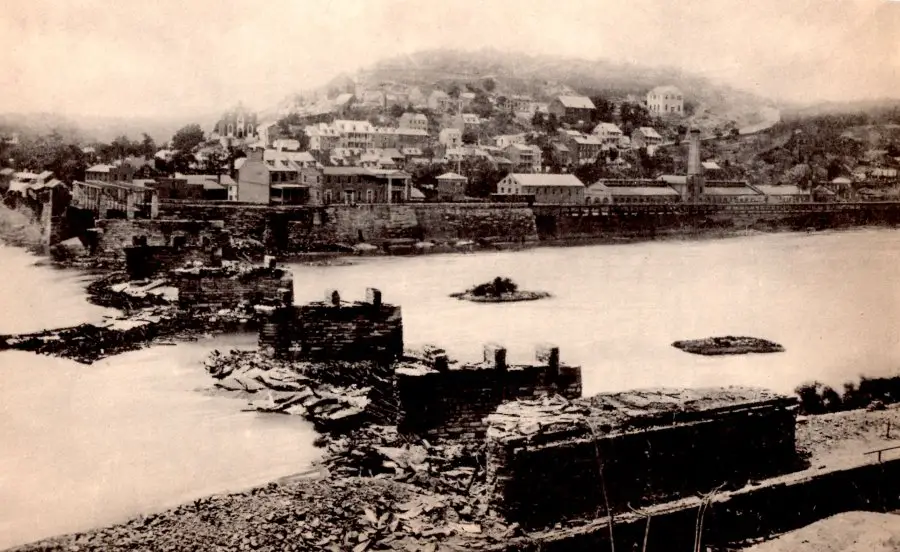
|
Battle of Antietam, looking north; showing dash of 7th Maine into the Piper cornfield, Cemetery Hill & Sharpsburg.
Photograph of sketch made on the field by Capt. James Hope, Co. B, 2nd Vermont Inf.
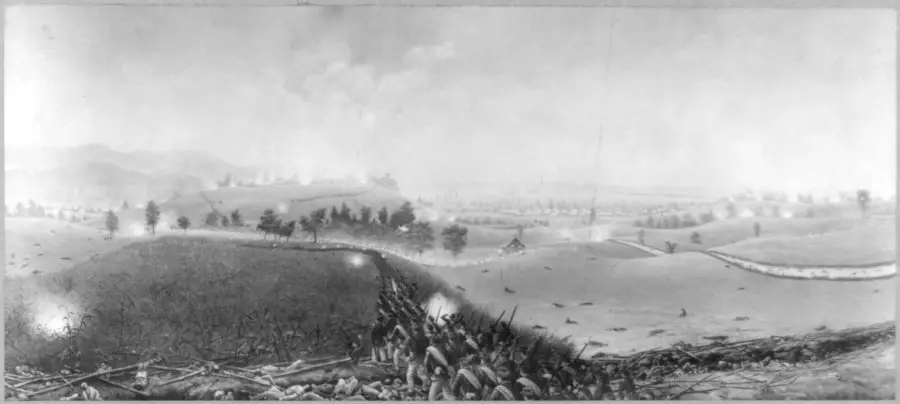
Kindle Available Standard Catalog of Civil War Firearms Over 700 photographs and a rarity scale for each gun, this comprehensive guide to the thousands of weapons used by Billy Yank and Johnny Reb will be indispensable for historians and collectors. |
More on Antietam Civil War Exhibits Women in the War State Battle Maps Civil War Pictures Civil War Timeline Ships and Naval Battles Battles by Campaign Civil War Submarines Civil War Cooking |
 Arms and Equipment of the Civil War Marvelous illustrations, the text describes what materiel was available to the armies and navies of both sides. Iron-clad gunboats, submarine torpedoes, and military balloons to pontoon bridges, percussion grenades, and siege artillery |
For the North, the fight along Antietam Creek became known as the Battle of Antietam. In the South, it became known as the Battle of Sharpsburg. Of the nearly 70,000 Federal troops actually engaged in the battle, nearly 13,000 were killed, wounded, or missing; the approximately 35,000 Confederates engaged lost almost as many. Writing to his wife, McClellan said, "Those in whose judgment I rely tell me that I fought the battle splendidly and that is was a masterpiece of art. "In truth, however, McClellan missed a series of opportunities. By failing to commit his forces to battle on 15 and 16 September, McClellan squandered a chance to exploit his numerical superiority. On 17 September McClellan's piecemeal commitment of only a portion of his command during the battle-"in driblets," as General Sumner later described it failed to deliver a knockout blow to destroy the Army of Northern Virginia. McClellan's decision not to renew the battle on 18 September, with the same if not greater opportunity of success as the previous day, as well as his failure to energetically pursue the Confederate army on 19 September, allowed Lee to withdraw to the safety of the Virginia shore. Lee, like McClellan, generally believed that the role of an army commander was to bring his army to the battlefield and allow his subordinates to handle the tactical details. But the desperate situation on 17 September forced Lee to become actively involved in the battle, despite injuries to both his hands. He spent most of the day on the heights in the area of the present day National Cemetery, where he watched the progress of the battle and personally dispatched various units to endangered portions of the field. He sent the commands of Walker, McLaws, and G. T. Anderson just in time to halt Sedgwick's advance on the Confederate left flank; rushed R. H. Anderson to support D. H. Hill's defense of the Confederate center; and, when A. P. Hill's division began arriving at Sharpsburg in the afternoon, hurried Hill's command to save the Confederate right flank. Although the Confederates had been forced out of Maryland, Lee's campaign had been a partial success. Jackson's capture of Harper's Ferry provided the Confederates with a large amount of supplies, including clothing, shoes, thousands of small arms and ammunition, and over seventy pieces of artillery. In addition, another major Federal offensive in Virginia had been delayed, albeit only briefly. In mid-December Burnside, now commanding The Army of the Potomac, attempted to interpose his command between Lee and Richmond. The maneuver culminated in a Union defeat at the Battle of Fredericksburg. Although Antietam was not the decisive Union victory for which Lincoln had hoped, it did give the president an opportunity to strike at the Confederacy politically, psychologically, and economically. On 22 September Lincoln issued the preliminary Emancipation Proclamation, declaring that the Federal government would after 1 January 1863 consider slaves in any state in rebellion against the Federal government to be free. The proclamation had no immediate effect behind Confederate lines, nor did it free any slaves in states still in the Union. Nevertheless, Lincoln's proclamation would be the Federal government's first official step toward the abolition of human slavery. Shortly after the battle, McClellan wrote that Confederate dreams of invading Pennsylvania had dissipated forever. During the coming months, however, Lee would wait for another opportunity to cross his army north of the Potomac. The summer of 1863 would find the Army of Northern Virginia and the Army of the Potomac, the latter commanded by the recently promoted Maj. Gen. George Meade, confronting each other at the small Pennsylvania town of Gettysburg. |
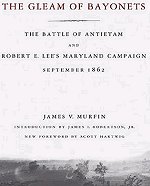 The Gleam Of Bayonets: The Battle Of Antietam And Robert E. Lee's Maryland Campaign, September, 1862 Antietam turned the tide of the Civil War in favor of the North and delivered the first major defeat to Robert E. Lee's Confederate army. The gentleness and patience of Lincoln, the vacillations of McClellan, and the grandeur of Lee—all unfold before the reader |
 Crossroads of Freedom: Antietam James M. McPherson states in his concise chronicle, it may well have been the pivotal moment of the war . The South had reversed the war's momentum during the summer, and was on not only on the "brink of military victory" but about to achieve diplomatic recognition by European nations Kindle Version |
 Antietam The Soldiers Battle In "Antietam: The Soldiers' Battle," author John Michael Priest tells the story of the American Civil War's bloodiest day using a compilation of eyewitness accounts. The book also includes 72 sketch maps of the battle. Between the plentiful maps and the chronologically-arranged accounts, the reader can follow the battle. |
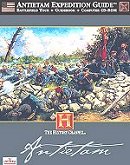 Antietam Expedition Guide Indespensible asset for understanding the battle that resulted in America's bloodiest day. The automated and time-scaled troup movement maps helps to grasp the scope and scale of the conflict |
 The Antietam Campaign |
The Antietam Campaign The Maryland campaign of September 1862 ranks among the most important military operations of the American Civil War. Crucial political, diplomatic, and military issues were at stake as Robert E. Lee and George B. McClellan maneuvered and fought in the western part of the state. The clash came on September 17 at the battle of Antietam, where more than 23,000 men fell in the single bloodiest day of the war. Approaching topics related to Lee's and McClellan's operations from a variety of perspectives, contributors to this volume explore questions regarding military leadership, strategy, and tactics, the impact of the fighting on officers and soldiers in both armies, and the ways in which participants and people behind the lines interpreted and remembered the campaign. They also discuss the performance of untried military units and offer a look at how the United States Army used the Antietam battlefield as an outdoor classroom for its officers in the early twentieth century . |
 George B. Mcclellan: The Young Napoleon By age 35, General George B. McClellan (1826�1885), designated the "Young Napoleon," was the commander of all the Northern armies. He forged the Army of the Potomac into a formidable battlefield foe, and fought the longest and largest campaign of the time as well as the single bloodiest battle in the nation's history |
 Maryland In The Civil War After Fort Sumter, the Lincoln administration could ill afford to lose Maryland, especially its principal city Baltimore, site of the first blood spilled when a mob attacked the Sixth Massachusetts Regiment. Maryland was the site of the greatest single day's carnage in American |
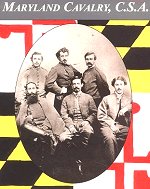 First and Second Maryland Cavalry C.S.A An indepth look at Maryland and her divided loyalties during the Civil War. Brother against brother epitomizes the state of affairs in Maryland. Men, loyal to the South, crossed the Potomac river at great personal peril to join Confederate ranks. |
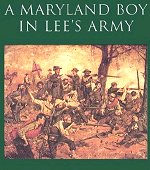 A Maryland Boy in Lee's Army: Personal Reminiscences of a Maryland Soldier in the War between the States, 1861-1865 Young George Wilson Booth followed the call of the Confederacy and served four years in the Army of Virginia. During the days of the successes at Manassas battles and in the Peninsula to the Valley |
 A southern star for Maryland Maryland and the secession crisis, 1860-61 Maryland did not freely choose to remain in the Union at the outbreak of the Civil War, this book argues: the state was held by brute force. A colorful account of the dilemmas faced by Marylanders in the crisis as seen from the Southern point of view. |
 Lee Vs. McClellan: The First Campaign An interesting account of the struggle for western Virginia in 1861. It follows that year's rolls of Generals McClellan and Lee; the former using the successes of the campaign to further his reputation and career, and the latter struggling to straighten out a quagmire and failing to do so |
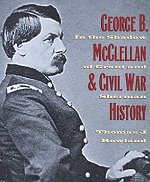 George B. McClellan and Civil War History In the Shadow of Grant and Sherman The complex general who, though gifted with administrative and organizational skills, was unable and unwilling to fight with the splendid army he had created. In this book, Rowland presents a framework in which early Civil War command can be viewed without direct comparison to the final two years of the war |
 Trench Warfare under Grant and Lee Field Fortifications in the Overland Campaign Narrative history of military operations in the Overland Campaign of May and June, 1864: the Wilderness, Spotsylvania, North Anna, and Cold Harbor. Describes Union and Confederate earthworks and how Grant and Lee used them in this new era of field entrenchments. |
Kindle Available The Civil War for Kids History explodes in this activity guide spanning the turmoil preceding secession, the first shots fired at Fort Sumter, the fierce battles on land and sea, and finally the Confederate surrender at Appomattox. Making butternut dye for a Rebel uniform, learning drills and signals with flags, decoding wigwag, baking hardtack, reenacting battles, and making a medicine kit bring this pivotal period in our nation's history to life. |
 Behind the Blue and Gray The Soldier's Life in the Civil War Civil War reading can be very dry, but not this book. Delia Ray takes us on a soldiers journey beginning with enlistment and ending with a soldiers life after the war, using quotes from actual letters and diaries strategically placed throughout the book. |
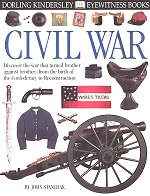 Eye Witness Civil War Eyewitness Civil War includes everything from the issues that divided the country, to the battles that shaped the conflict, to the birth of the reunited states. Rich, full-color photographs of rare documents, powerful weapons, and priceless artifacts plus stunning images of legendary commanders, unsung heroes, and memorable heroines |
Kindle Available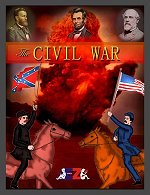 The Civil War Introduces young readers to the harrowing true story of the American Civil War and its immediate aftermath. A surprisingly detailed battle-by-battle account of America's deadliest conflict ensues, culminating in the restoration of the Union followed by the tragic assassination of President Lincoln |
|
Battle of Shiloh Civil War Map First Manassas Civil War Pictures Civil War Cooking Gettysburg Civil War Ships |
Sources:
National Park Service
Library of Congress
Unites States Army